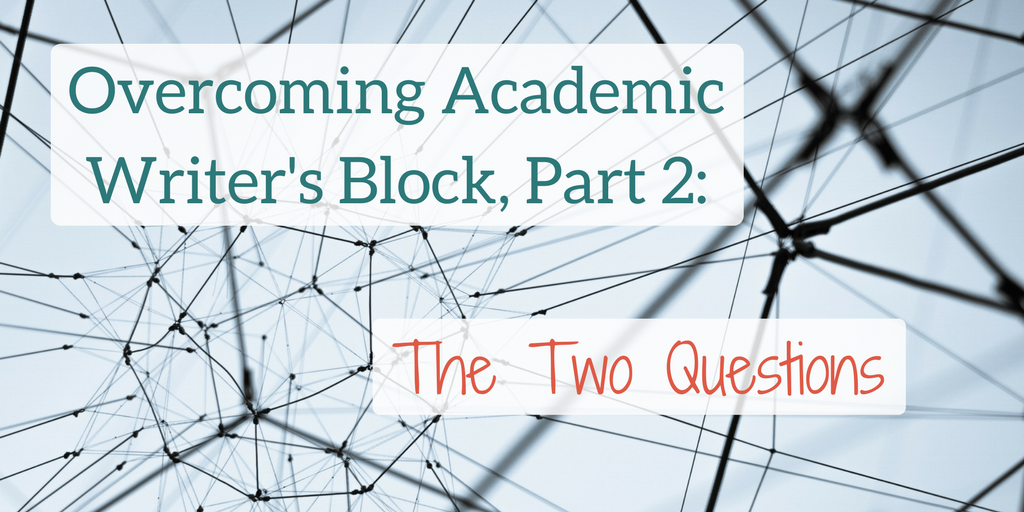Are you stuck with a stubborn academic conference paper, journal article, or book chapter? Are you experiencing academic writer’s block and are looking for unique solutions to help you get unstuck?
Today’s post draws together my earlier post on overcoming academic writer’s block by writing two sentences, and an incredibly useful exercise found in “Week 2” of Wendy Belcher’s superb book Writing Your Journal Article in Twelve Weeks
One most revolutionary ideas I took from Belcher’s workbook (which I can’t recommend highly enough for grad students and early career researchers) was her straightforward answer to what an article is. For Belcher, an article needs to be “organized around a single significant new idea that is demonstrably related to what has come before” (49). Simple yet elegant.
As Jensen illustrates in Write no Matter What, academic writers often subscribe to the “magnum opus myth”–the idea that publishable writing must revolutionize the field. This myth frightens many writers from making the incremental contributions that move their field forward. (Her other articles on academic writing myths [Google “Jensen writing myths”] are also well worth reading).
Despite what it sounds like, Belcher’s “single significant new idea” is not, in fact, the “magnum opus” approach. She identifies three ways journal articles can structure their “new idea”: 1) approach new evidence in an old way, 2) analyze old evidence in a new way; or 3) pair old approaches with old evidence in a new way.
Today we’re going to use this model in a way Belcher did not explicitly intend. We’re going to use models 1 (new evidence/old way) and 2 (old evidence in new way) to imagine what future scholars (including your future self) might do after having read your article or chapter.
In the previous activity, I talked about the “Two Sentence Method” for overcoming writer’s block. I asked you to complete the following two sentences:
After reading this article you will understand… So that you can…
Today you will make the “so you can” concrete. You will imagine how others might apply your methodology/argument (old way) to different texts (new evidence). You will also imagine how someone might approach those same texts/objects you analyze (old evidence) using a new lens or methodology (new way). Doing so should help you not only refine your own ideas, but also clarify how your article or chapter fits within scholarly terrain that will continue to evolve in the coming years.
Identifying what Scholars will DO with your work
Answer the following questions:
Question 1: Is my methodology portable?
Think about a scholar applying this model in a different field, and make a list of disciplines, texts, etc. in which you could reasonably see your methodology working. How might someone apply the model/methodology you develop in your publication to different (new) evidence?
Question 2: Can my work be complemented?
Think about what your approach must necessarily–and deliberately–leave out. How might someone approach the same evidence you do in your publication in a new way that complements yours? Note that answering this question gives you permission to deliberately and unapologetically keep your article’s focus narrow. You might even consider announcing those analyses that fall outside the scope of your article as a way to invite others to return to and engage your necessarily limited analyses.
Reflection
As always, doing the activity is only the first step. I strongly suggest you answer the following questions:
- How can you use your answer to question 1 to foreground your methodology in a way that will be useful to other scholars ?
- What did you learn about the general or particular applicability of your model/methodology in answering question 1? How will you use this knowledge to revise your publication?
- I find answering question 2 liberating: it reminds us that we cannot do everything in the space of one article. What pieces of the current iteration of your project can be “let go” and revisited in a future project?
- Finally, if this piece of writing is a journal article, reflect on whether you have selected the right venue for publication. If you discover your argument is more generalizable than you’d initially realized, consider targeting a publication with a broader scope. If its applicability appears narrower, consider targeting a more specialized journal. If you are still unsure about how to choose the right journal for the project, consult Wendy Belcher’s excellent advice on how to find a suitable journal for your article.
Have you tried the two questions? How did it work for you? I’d love to hear about it in the comments below or by email! Write on!
